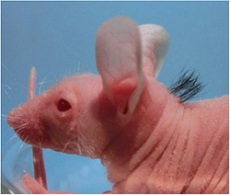Virtually all hair related research at universities, clinics and private labs starts with experimentation in mice or rats. In some cases, they move on to hamsters and macaques.
Per the Foundation for Biomedical Research, 95 percent of all lab animals are mice and rats. I am guessing that the smaller sized mice represent a much higher share of this 95 percent in comparison to the larger sized rats.
During my research for this post, I read that one of the main differences between mice and rats is that while the former are very curious, the latter are fairly cautious. i.e., the smaller rodent is braver (or more foolish) than the larger rodent. When I saw “Rats”, I did not find rats to be particularly cautious. According to that documentary, rats are the most successful species on earth. They will surely outlast us, as will cockroaches.
Successful Hair Growth in Mice and Rats
Since I first started writing this blog, the single biggest pet peeve of most readers as well as myself has been:
Why is hair loss regularly cured in mice and other rodents, but never in humans?
Forget the word “cure”. Even a moderately effective hair loss treatment would be welcome. The countless groundbreaking successes in hair regrowth in mice over the past several decades have never even translated into any major hair loss treatment for humans. This travesty has been going on for way too long.

All we can do is hope than sooner or later, someone like Dr. Tsuji will emulate his success in mice -> to success in humans -> to a final product release. In many cases, positive results in mice and then in small-scale human trials never progress to a final product release due to lack of funding or corporate interest.
However, this should change in the next several years as a number of companies start or complete final Phase 3 clinical human trials for various new hair growth products.
The main reasons researchers like to use mice and rats for their hair loss research work are:
- Low cost.
- An abundant and plentiful supply.
- Small creature size making housing, feeding and maintenance relatively easy.
- Short 2-3 year lifespan making generational study possible.
- Mice and humans share about 97.5 percent of their working DNA. Almost as similar as the relationship between humans and the great apes.
Two New Hair Loss Cures in Mice in July 2018
Note: I am a bit uncertain if mouse or rat fur can be compared to human scalp hair more than to human body hair. In humans, scalp hair and body hair often have an inverse relationship.
Mitochondrial Repair and Hair Growth
As a result of the earlier mentioned pet peeve, I initially decided to ignore the biggest hair loss related news story of this month from several weeks ago. Scientists from the University of Alabama (led by Dr. Keshav Singh of Yuva Biosciences) managed to reverse hair loss and skin wrinkling in mice. Actual study findings are here. The scientists managed to reverse mitochondrial dysfunction (which they induced in the first place), which in turn reversed hair loss and wrinkling in mice.

This news was covered extensively by the global media. I decided to skip writing about these findings, and instead focused on keeping my posts on the important recent developments from Histogen and Cassiopea on the front page of this blog a little longer. Both of these companies are going to complete final Phase 3 trials in humans in the next several years. In contrast, The University of Alabama research might not even ever make it to Phase 1 trials in humans.
Reversal of Fatty Diet Associated Hair Loss and Hair Whitening
However, yesterday came news of yet another major development in regards to scientists curing hair loss in mice. So I finally had to write this post on rodents getting back their hair (and their hair color and their youthful skin) twice in the past two weeks. It is ironic that rodents do not even care one iota about their appearance.

This time, the latest research was in regards to hair loss in mice that was associated with a bad “western” diet high in fat and cholesterol. Actual study findings are here. The cure entails daily ingestion of a pill that the mice will have to remember to take. The compound halts the production of certain types of fats known as glycosphingolipids (GSLs).
The research was undertaken by scientists at Johns Hopkins University (led by Dr. Subroto Chatterjee). One of the interesting quotes in relation to this work was that:
“Current research shows that mice fed a diet high in fat and cholesterol are more likely to have hair discoloration from black to gray to white, extensive hair loss and inflammation of skin exhibited by multiple wounds.”
Long-time readers of this blog will know that this link between bad diet and hair loss has often been blamed for increasing hair loss in Japanese men since the end of World War II. I think that men and women in all countries are losing hair at earlier ages than in past generations. I was never too keen about this diet and hair loss argument, but perhaps there is something to it?